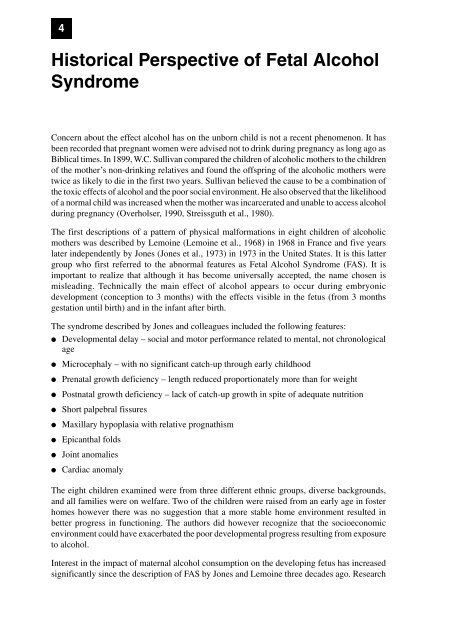Fetal Alcohol Syndrome A literature review - Department of Health ...
Fetal Alcohol Syndrome A literature review - Department of Health ...
Fetal Alcohol Syndrome A literature review - Department of Health ...
You also want an ePaper? Increase the reach of your titles
YUMPU automatically turns print PDFs into web optimized ePapers that Google loves.
4<br />
Historical Perspective <strong>of</strong> <strong>Fetal</strong> <strong>Alcohol</strong><br />
<strong>Syndrome</strong><br />
Concern about the effect alcohol has on the unborn child is not a recent phenomenon. It has<br />
been recorded that pregnant women were advised not to drink during pregnancy as long ago as<br />
Biblical times. In 1899, W.C. Sullivan compared the children <strong>of</strong> alcoholic mothers to the children<br />
<strong>of</strong> the mother’s non-drinking relatives and found the <strong>of</strong>fspring <strong>of</strong> the alcoholic mothers were<br />
twice as likely to die in the first two years. Sullivan believed the cause to be a combination <strong>of</strong><br />
the toxic effects <strong>of</strong> alcohol and the poor social environment. He also observed that the likelihood<br />
<strong>of</strong> a normal child was increased when the mother was incarcerated and unable to access alcohol<br />
during pregnancy (Overholser, 1990, Streissguth et al., 1980).<br />
The first descriptions <strong>of</strong> a pattern <strong>of</strong> physical malformations in eight children <strong>of</strong> alcoholic<br />
mothers was described by Lemoine (Lemoine et al., 1968) in 1968 in France and five years<br />
later independently by Jones (Jones et al., 1973) in 1973 in the United States. It is this latter<br />
group who first referred to the abnormal features as <strong>Fetal</strong> <strong>Alcohol</strong> <strong>Syndrome</strong> (FAS). It is<br />
important to realize that although it has become universally accepted, the name chosen is<br />
misleading. Technically the main effect <strong>of</strong> alcohol appears to occur during embryonic<br />
development (conception to 3 months) with the effects visible in the fetus (from 3 months<br />
gestation until birth) and in the infant after birth.<br />
The syndrome described by Jones and colleagues included the following features:<br />
● Developmental delay – social and motor performance related to mental, not chronological<br />
age<br />
●<br />
●<br />
●<br />
●<br />
●<br />
●<br />
●<br />
●<br />
Microcephaly – with no significant catch-up through early childhood<br />
Prenatal growth deficiency – length reduced proportionately more than for weight<br />
Postnatal growth deficiency – lack <strong>of</strong> catch-up growth in spite <strong>of</strong> adequate nutrition<br />
Short palpebral fissures<br />
Maxillary hypoplasia with relative prognathism<br />
Epicanthal folds<br />
Joint anomalies<br />
Cardiac anomaly<br />
The eight children examined were from three different ethnic groups, diverse backgrounds,<br />
and all families were on welfare. Two <strong>of</strong> the children were raised from an early age in foster<br />
homes however there was no suggestion that a more stable home environment resulted in<br />
better progress in functioning. The authors did however recognize that the socioeconomic<br />
environment could have exacerbated the poor developmental progress resulting from exposure<br />
to alcohol.<br />
Interest in the impact <strong>of</strong> maternal alcohol consumption on the developing fetus has increased<br />
significantly since the description <strong>of</strong> FAS by Jones and Lemoine three decades ago. Research

















